Understanding Housing Management by Low-income Homeowners: Technical, Organisational and Sociocultural Challenges in Chilean Condominium Housing
Abstract
1. Introduction
Condominium Management in Chile: Regulations, Policies and Actors
2. Multidimensional Framework for Condominium Management
- The management is a multidimensional process which goes beyond technical features, involving sociocultural and organisational dimensions. The final outcome is to achieve quality in the built environment and to guarantee the value of the house as an asset for vulnerable groups.
- The main actors of the process are the households, with their own socioeconomic and cultural dynamics. The decisions related to the built environment are part of the private domain and are voluntary in nature.
- There are internal and contextual elements that might positively or negatively affect management practices. Internal elements are related to the dynamics inside the condominium and depend on the co-owners as individuals and as a community, and contextual elements are related to the context conditions and depend on the institutional sphere and its policies.
3. Materials and Methods
3.1. Interviews with Professionals
3.2. Interviews with Condominium Residents
4. Results
4.1. Perception of Management Dimensions and Challenges among Chilean Institutions, Researchers and Asistance Entities
4.2. Perception of Management Dimensions and Challenges among Condominium Residents
5. Discussion
5.1. Interrelations between Management Dimensions: Identification of Main Triggers
5.2. Considerations for Future Actions
6. Conclusions
Author Contributions
Funding
Conflicts of Interest
References
- Moser, C.O.N. The asset vulnerability framework: Reassessing urban poverty reduction strategies. World Dev. 1998, 26, 1–19. [Google Scholar] [CrossRef]
- Bredenoord, J.; van Lindert, P. Pro-poor housing policies: Rethinking the potential of assisted self-help housing. Habitat Int. 2010, 34, 278–287. [Google Scholar] [CrossRef]
- Gough, K.V.; Kellett, P. Housing consolidation and home-based income generation: Evidence from self-help settletments in two Colombian cities. Cities 2001, 18, 235–247. [Google Scholar] [CrossRef]
- Acquaye, L. Low-income homeowners and the challenges of home maintenance. Community Dev. 2011, 42, 16–33. [Google Scholar] [CrossRef]
- Camargo, A.; Hurtado, A. Vivienda y pobreza: Una relación compleja. Marco conceptual y caracterización de Bogotá. Cuad. Vivienda Urban. 2011, 4, 23. [Google Scholar]
- Gruis, V.; Tsenkova, S.; Nieboer, N. Management of Privatised Housing: International Policies & Practice; John Wiley & Sons: Chichester, UK, 2009. [Google Scholar]
- Liias, R. Housing maintenance management: The key-factor when creating healthy environment. Int. J. Environ. Pollut. 2007, 30, 457–470. [Google Scholar] [CrossRef]
- Van Zandt, S.; Rohe, W.M. The sustainability of low-income homeownership: The incidence of unexpected costs and needed repairs among low-income home buyers. Hous. Policy Debate 2011, 21, 317–341. [Google Scholar] [CrossRef]
- Kessler, G.; di Virgilio, M.M. The new urban poverty: Global, regional and Argentine dynamics during the last two decades. Cepal Rev. 2008, 95, 31–50. [Google Scholar] [CrossRef]
- Donoso, R. Governance of condominium affordable housing in Latin America; a network analysis. In Proceedings of the at Home with the Housing Market Conference of ISA RC43 Housing and Built Environment, University of Amsterdam, Amsterdam, The Netherlands, 10–12 July 2013. [Google Scholar]
- Yau, Y. Willingness to participate in collective action: The case of multiowned housing management. J. Urban Aff. 2013, 35, 153–171. [Google Scholar] [CrossRef]
- Yau, Y. Normas, sentido de comunidad y colectivismo comunal en un contexto de edificios en altura. Rev. INVI 2012, 27, 17–72. [Google Scholar] [CrossRef]
- Yau, Y. Perceived efficacies and collectivism in multi-owned housing management. Habitat Int. 2014, 43, 133–141. [Google Scholar] [CrossRef]
- Marcuse, P. Homeownership for Low Income Families: Financial Implications. Land Econ. 1972, 48, 134–143. [Google Scholar] [CrossRef]
- Derrick, F.; Scott, C.; Kolbre, E. Estonian dwelling owners’ association and maintenance policy: The conflict of policy goals and incentives. Eur. Asia Stud. 1999, 51, 1285–1294. [Google Scholar] [CrossRef]
- Ducci, M.E. Chile: El lado obscuro de una política de vivienda exitosa. EURE (Santiago) 1997, 23, 99–115. [Google Scholar]
- Rodriguez, A.; Sugranyes, A. El problema de vivienda de los “con techo”. In Los Con Techo. Un Desafío Para la Política de Vivienda Social; Rodriguez, A., Sugranyes, A., Eds.; Ediciones SUR: Santiago, Chile, 2005. [Google Scholar]
- Brain, I.; Iacobelli, A.; Sabatini, F. Reporte: Calidad y Valor de la Vivienda Social: Un problema de localización y Barrio; ProUrbana. Centro de Políticas Públicas UC: Santiago, Chile, 2005. [Google Scholar]
- Brain, I.; Mora, P.; Rasse, A.; Sabatini, F. Report on Social Housing Chile; ProUrbana. Centro de Políticas Públicas UC: Santiago, Chile, 2009. [Google Scholar]
- Gilbert, A. Helping the poor through housing subsidies: Lessons from Chile, Colombia and South Africa. Habitat Int. 2004, 28, 13–40. [Google Scholar] [CrossRef]
- MINVU. Vivienda Social en Copropiedad. Memoria de Tipologias de Condominios Sociales; Ministerio de Vivienda y Urbanismo: Santiago, Chile, 2014.
- Oezler, S.I. The Concertacion and Homelessness in Chile Market-based Housing Policies and Limited Popular Participation. Lat. Am. Perspect. 2012, 39, 53–70. [Google Scholar] [CrossRef]
- Rodríguez, A.; Sugranyes, A. Los Con Techo: Un Desafío Para la Política de Vivienda Social; Ediciones SUR: Santiago, Chile, 2005; 265p. [Google Scholar]
- Rubio Vollert, R. Lecciones de la política de vivienda en Chile. Bitacora 2006, 10, 197–206. [Google Scholar]
- MINVU. Vivienda Social en Copropiedad. Catastro Nacional de Condominios Sociales; Ministerio de Vivienda y Urbanismo: Santiago, Chile, 2014.
- MINVU. Ley 20.741 Modifica la ley N° 19.537, Sobre Copropiedad Inmobiliaria Para Facilitar la Administracion de Copropiedades y la Presentación de Proyectos de Mejoramiento o Ampliacion de Condominios de Viviendas Sociales; Ministerio de Vivienda y Urbanismo: Santiago, Chile, 2014.
- Priemus, H.; Dieleman, F.; Clapham, D. Current developments in social housing management. Neth. J. Hous. Built Environ. 1999, 14, 211–223. [Google Scholar] [CrossRef]
- Gruis, V.; Nieboer, N.; Thomas, A. Strategic asset management in the social rented sector: Approaches of Dutch and English housing associations. Urban Stud. 2004, 41, 1229–1248. [Google Scholar] [CrossRef]
- Straub, A. Housing management and maintenance practise of Dutch housing associations. In Proceedings of the ENHR 2004 Conference, Cambridge, UK, 2–6 July 2004. [Google Scholar]
- Walker, R.M. The changing management of social housing: The impact of externalisation and managerialisation. Hous. Stud. 2000, 15, 281–299. [Google Scholar] [CrossRef]
- Straub, A. Maintenance and Repair. In International Encyclopedia of Housing and Home; Smith, S.J., Ed.; Elsevier: San Diego, CA, USA, 2012; pp. 186–194. [Google Scholar]
- Ariff, N.R.M.; Davies, H. Multi-owner low-cost housing management in Malaysia: Effects of owner-occupant characteristics and occupancy rates. Int. J. Hous. Mark. Anal. 2011, 4, 268–289. [Google Scholar] [CrossRef]
- Donoso, R.E.; Elsinga, M. Management of low-income condominiums in Bogotá and Quito: The balance between property law and self-organisation. Int. J. Hous. Policy 2018, 18, 312–334. [Google Scholar] [CrossRef]
- Reid, S. Exploring social interactions and sense of community in multi-owned properties. Int. J. Hous. Mark. Anal. 2015, 8, 436–450. [Google Scholar] [CrossRef]
- Olson, M., Jr. The Logic of Collective Action: Public Goods and the Theory of Groups, 9th ed.; Harvard economic studies; Harvard University Press: Cambridge, MA, USA, 1982; Volume 124. [Google Scholar]
- Ostrom, E. Governing the Commons. The Evolution of Institutions for Collective Action; Cambridge University Press: Cambridge, UK, 1990. [Google Scholar]
- Chen, S.C.Y.; Webster, C.J. Homeowners Associations, Collective Action and the Costs of Private Governance. Hous. Stud. 2005, 20, 205–220. [Google Scholar] [CrossRef]
- Chu, F.N.; Chang, C.O.; Sing, T.F. Collective Action Dilemmas in Condominium Management. Urban Stud. 2013, 50, 128–147. [Google Scholar] [CrossRef]
- Pérez, A. Copropiedad Inmobiliaria. In Precariedad y Organización: El Caso del Condominio Quillayes de la Comuna de La Florida, in Instituto de Estudios Urbanos y Territoriales; Pontificia Universidad Católica de Chile: Santiago, Chile, 2009; p. 183. [Google Scholar]
- Gao, L.W.; Ho, D.C.W. Explaining the outcomes of multi-owned housing management: A collective action perspective. Habitat Int. 2016, 57, 233–241. [Google Scholar] [CrossRef]
- Ostrom, E. Background on the Institutional Analysis and Development Framework. Policy Stud. J. 2011, 39, 7–27. [Google Scholar] [CrossRef]
- Cavalheiro, D.D.; Abiko, A. Evaluating slum (favela) resettlements: The case of the Serra do Mar Project, Sao Paulo, Brazil. Habitat Int. 2015, 49, 340–348. [Google Scholar] [CrossRef]
- Teles, R.; González, M.S. Social housing enlargement—Case of study: Ivoti—Brazil. Rev. Ing. Constr. 2013, 28, 237–250. [Google Scholar] [CrossRef]
- Marquez, F. De lo Material y lo Simbólico en la Vivienda Social. In Los Con Techo: Un Desafío Para la Política de Vivienda Social; Rodríguez, A., Sugranyes, A., Eds.; Ediciones SUR: Santiago, Chile, 2005. [Google Scholar]
- Gao, W.; Chen, G.-Z. Does owner heterogeneity matter in the management of multi-owned housing? Habitat Int. 2016, 53, 106–114. [Google Scholar] [CrossRef]
- Smithson, J. Using and analysing focus groups: Limitations and possibilities. Int. J. Soc. Res. Methodol. 2000, 3, 103–119. [Google Scholar] [CrossRef]
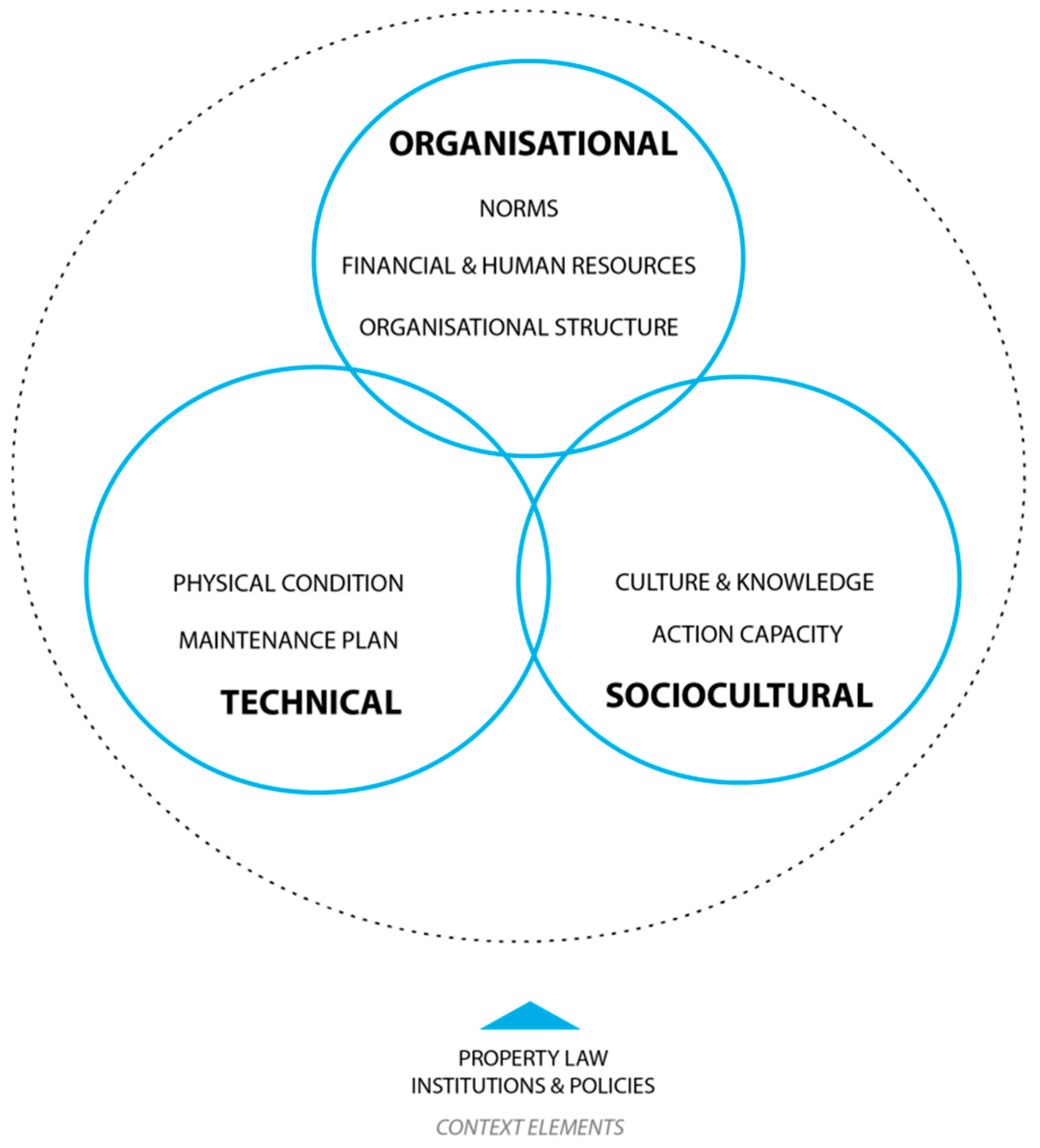
| Problematic Uses in Condominiums | Description | Graphic Register |
|---|---|---|
| Appropriation of common land | Use of the common land on the ground floor for individual and private purposes without the consent of the condominium. Most common uses are gardens, garages, parking, storage, informal shops |  (Source: Author’s picture) |
| Irregular housing extension | Extensions that alter the appearance of the building or are attached to the building on different floors (except ground floor) The extensions are usually made out using precarious material and design, thus they do not meet structural and security requirements, especially regarding fires and earthquakes. | 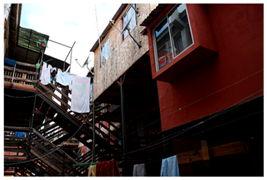 (Source: Author’s picture) |
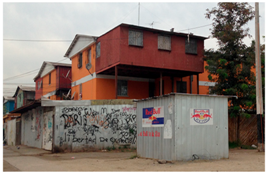 (Source: Author’s picture) | ||
| Dump areas inside condominiums | Presence of garbage inside the condominiums. Areas of collective ownership become useless for their original purpose. | 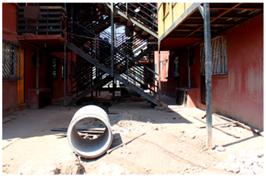 (Source: Fundación Proyecto Propio) |
| Vacant lots | Empty areas inside the condominium plot, usually destined to be green areas that were never built. | 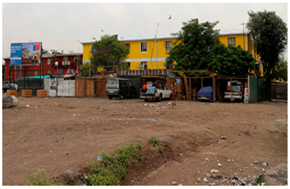 (Source: Fundación Proyecto Propio) |
| Dimension | Elements | Description |
|---|---|---|
| Technical | Physical conditions | Characteristics of the building regarding its structure, thermal comfort, security, design and aesthetic appearance. |
| Maintenance level | Activities that are carried out in order to maintain a building or its parts in a state in which it can perform its required functions. It distinguishes between the type of activities (i.e., improvement and/or repair) and their organisation through time (i.e., short-term and long-term actions). | |
| Organisational Sociocultural | Norms | Internal formal and informal regulations that establish the conditions to develop and coordinate housing management activities. |
| Financial and human resources | Internal or external resources needed for the management. - Financial resources: Financial capacity to carry out maintenance activities. The resources are divided into two types according to activities: Resources for short-term maintenance or routine maintenance, and resources for long-term maintenance, which in collective buildings are part of a maintenance fund. It is also possible to identify internal financial resources that come from the owners’ financial capacity and external financial resources that come from government subsidies, affordable loans or other private contributions. - Human resources: Co-owners and professionals are required to perform and coordinate the administrative and technical activities. Human resources can be either internal or external. Internal human resources are the individuals who belong to the condominiums (for instance, members of the condominium board, volunteer administrators) and external human resources are professionals or organisations hired by the co-owners (for instance, contractors to perform technical maintenance, property managers or agencies). | |
| Organisational structure | Umbrella institution or group where the activities are carried out. In the case of condominiums, the formal structure is the assembly of co-owners, named in some contexts as the homeowner association. It also includes alternative organisational structures that contribute to the internal governance. | |
| Culture and knowledge | Collective perception and behaviour of the community group about housing management activities. For instance, the perception of maintenance as a collective duty or an individual task, the importance (or not) of maintenance as part of the routine. The culture and knowledge of maintenance is also related to the educational background and residential trajectories of residents. | |
| Action capacity | The willingness and capacity of co-owners to carry out the management activities. In condominiums, this capacity will depend on the collective action of the group working together to achieve the objective of housing management, and the presence of elements such as social capital and trust in the leaders. | |
| Contextual elements | Property law | Formal legal framework that regulates condominium tenure and defines property rights and obligations. |
| Institutions and policies | Private or public institutions that participate in condominium management practices at an external governance level. It also comprises the policies that impact the management of the condominiums |
| # | Questionnaire |
|---|---|
| Q#1 | What, in your opinion, are the main technical problems/issues of housing management* in Chile? |
| Q#2 | What in your opinion, are the main organisational problems/issues of housing management* in Chile? |
| Q#3 | What, in your opinion, are the main social/cultural problems of housing management* in Chile? |
| Q#4 | Do you think that there are other types of problems/issues which are not considered in the previous categories? What are they? |
| Q#5 | If you had to order hierarchically the problems mentioned. What would be the main three problems? |
| Q#6 | What should be, in your opinion, the course of action to improve housing maintenance in Chile? What are the opportunities and threats? |
| # | Questionnaire |
|---|---|
| Q#1 | When we talk about housing maintenance, which activities come to your mind? |
| Q#2 | How do you maintain your dwellings, which activities do you do regularly and occasionally? |
| Q#3 | What were the main management problems* before the improvement of the condominium? |
| Q#4 | What are the main management problems* now, after the improvement of the condominium? |
| Q#5 | What did you learn from the improvement process? |
| # | Management Problems Noted by Stakeholders | Elements Addressed |
|---|---|---|
| Technical dimension of condominium management | ||
| 1 | Need to differentiate between extensions, improvement and maintenance | Maintenance plan |
| 2 | General physical deterioration due to the lack of maintenance | Maintenance plan Physical condition |
| 3 | Deterioration of common property areas in condominiums | Physical condition |
| 4 | Informality and precariousness of housing extensions and safety risks associated with them | Physical condition |
| 5 | Lack of quality in solutions implemented due to the lack of financial resources (subsidy and DIY) | Physical condition |
| 6 | Initial low-quality conditions of the housing stock | Context—institutions and policies |
| 7 | Specific architectural and constructive problems (toxic material in roofs, poor thermal isolation, lack of ventilation) | Physical condition |
| Organisational dimension of condominium management | ||
| 1 | Unclear responsibilities in housing maintenance | Context—institutions |
| 2 | Community does not trust in the system and its institutions | Norms Context—property law and institutions |
| 3 | Limited financial capacity of homeowners to invest in maintenance | Financial resources |
| 4 | Assistance entities and the externalisation of the work (subsidy process) | Context—institutions |
| 5 | Shortcomings in the implementation of the subsidy programmes for improvements (subsidy process) | Context—institutions |
| 6 | Passive homeowners and decrease of collective organisation | Organisational structure |
| 7 | Sustainability and success of the interventions (subsidy process) | Context—institutions |
| 8 | Inexistence of policies about maintenance | Context—institutions and policies |
| Sociocultural dimension of condominium management | ||
| 1 | Lack of awareness and education about housing maintenance | Culture and knowledge |
| 2 | Problems of community organisation and individualism among households | Action capacity |
| 3 | Lack of knowledge about the co-property law | Culture and knowledge Norms |
| 4 | Reproduction of behaviour patterns of informal settlements in new houses | Culture and knowledge |
| 5 | Lack of commitment of families to take care of the projects after completion (subsidy process) | Action capacity |
| 6 | Families priorities and allegamiento | Culture and knowledge |
| 7 | New type of society and poverty | Action capacity |
| 8 | Quality of neighbourhoods and buildings impacts on mental wellbeing | Action capacity |
| * In grey, the topics that were mentioned at least by one participant per type of stakeholder | ||
| # | Management Problems Noted by Residents | Elements Addressed |
|---|---|---|
| Technical dimension of condominium management | ||
| 1 | Appropriation of common property on the ground floor blocking emergency exits | Physical conditions |
| 2 | General critical physical deterioration | Maintenance plan |
| 3 | Specific architectural problems (deteriorated roofs, presence of contaminant materials (asbestos), collapse of rain gutters, structural damage due to earthquakes) | Physical conditions |
| 4 | Existence of plagues of animals and insects | Physical conditions |
| 5 | Courtyards converted into rubbish areas | Maintenance plan |
| 6 | Initial low-quality—need for space and extensions on upper floors | Context—institutions and policies |
| Organisational dimension of condominium management | ||
| 1 | Reluctance to pay monthly expenses | Financial resources |
| 2 | Workload for committee members | Human resources |
| 3 | Residents are reluctant to become a formal condominium | Organisational structure |
| 4 | Municipality could give more support to condominiums | Context—institutions and policies |
| 5 | Overlapping roles and conflicts with neighbourhood associations | Context—institutions and policies |
| 6 | Bilateral and informal agreements between co-owners to use common areas | Norms |
| 7 | Difficulties in organising big condominiums | Organisational structure |
| Sociocultural dimension of condominium management | ||
| 1 | Bad habits and negative attitudes among residents | Culture and knowledge |
| 2 | Individualism about cooperating and participating in collective initiatives | Action capacity |
| 3 | Distrust in the administrative committee | Action capacity |
| 4 | Conflicts between residents, especially between ground floor and upper floor residents | Culture and knowledge |
| 5 | Lack of knowledge about duties and rights regarding co-ownership | Culture and knowledge Norms |
© 2019 by the authors. Licensee MDPI, Basel, Switzerland. This article is an open access article distributed under the terms and conditions of the Creative Commons Attribution (CC BY) license (http://creativecommons.org/licenses/by/4.0/).
Share and Cite
Vergara, L.M.; Gruis, V.; van der Flier, K. Understanding Housing Management by Low-income Homeowners: Technical, Organisational and Sociocultural Challenges in Chilean Condominium Housing. Buildings 2019, 9, 65. https://doi.org/10.3390/buildings9030065
Vergara LM, Gruis V, van der Flier K. Understanding Housing Management by Low-income Homeowners: Technical, Organisational and Sociocultural Challenges in Chilean Condominium Housing. Buildings. 2019; 9(3):65. https://doi.org/10.3390/buildings9030065
Chicago/Turabian StyleVergara, Luz María, Vincent Gruis, and Kees van der Flier. 2019. "Understanding Housing Management by Low-income Homeowners: Technical, Organisational and Sociocultural Challenges in Chilean Condominium Housing" Buildings 9, no. 3: 65. https://doi.org/10.3390/buildings9030065
APA StyleVergara, L. M., Gruis, V., & van der Flier, K. (2019). Understanding Housing Management by Low-income Homeowners: Technical, Organisational and Sociocultural Challenges in Chilean Condominium Housing. Buildings, 9(3), 65. https://doi.org/10.3390/buildings9030065





